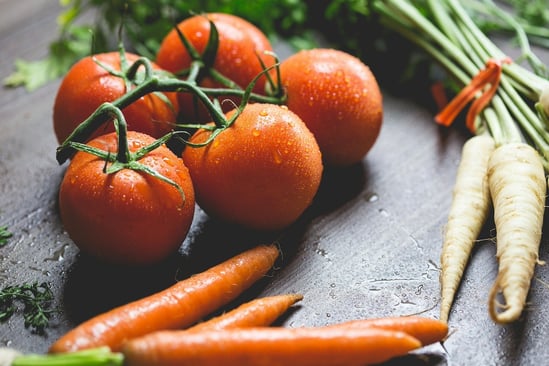What Are the Most Exciting Innovations Reshaping Grocery Retail?

The grocery market is changing, with new tools and technologies paving the way for enhanced customer experiences and intelligent data analytics.
For grocery brands, this creates an opportunity — if they can select, deploy, and manage the right combination of cutting-edge tools.
Here’s a look at some of the most exciting innovations reshaping grocery retail, and how companies can make the most of new tech to improve short- and long-term return on investment (ROI).
Why Grocery Brands Can’t Afford To Fall Behind
Grocery ecommerce is on the rise.
According to data from Mintel, 13.1% of all U.K. grocery store sales were online in 2023, and 17% of customers said they used rapid home delivery for their purchases.
While third-party delivery services such as Getir and Gorillas have announced they’re leaving the U.K., supermarkets have stepped in to create their own branded services, such as Tesco Whoosh.
In Germany, meanwhile, Statista predicts that user penetration in the grocery market will reach 29.1% in 2024, with an average revenue per user (APRU) of $375.80 USD.
In the U.S., online grocery retail grew by 18.4% last year, and eMarketer predicts that by 2026, grocery will become the largest ecommerce category in the country.
The result is a grocery market with both more customers and more competition. If brands can’t distinguish themselves in the growing market, or if they find themselves beaten on service or price by ecommerce or physical stores, they can quickly face unsustainable operations.
Consider Salsify’s consumer research data, which reports that 78% of U.S. shoppers are now looking for discounts or free delivery to offset the growing cost of products. While NPR notes that grocery costs have mostly leveled off after three years of steady growth, leveling off isn’t the same as going down, meaning consumers nationwide are feeling the crunch.
If brands can’t deliver experiences that reflect consumer priorities, they risk losing customers who have plenty of other choices. And if companies start falling behind, the increasing pace of change makes it almost impossible to catch up.
Top Tech: 6 Solutions That Are Changing Grocery Retail
To capture customer interest and keep them coming back, brands need to deploy solutions that speak to changing consumer preferences. Here are six solutions making significant strides.
1. Automated Checkout Systems
Automated checkout systems can reduce the time required for customers to complete their purchases. As noted by Grocery Dive, more than 217,000 self-checkout terminals were delivered globally in 2023, up 12% from the previous year.
What makes checkout automation successful? Managing speed and shrinkage. If terminals are complicated or directions are unclear, customers may avoid using them. Companies also need a way to ensure that products scanned match the products in consumer baskets.
For ecommerce retailers, meanwhile, improving the checkout experience may include offers of free shipping and returns, discounts on customers’ first orders, and the ability to check out as a guest without creating an account.
2. Smart Shelves and Digital Price Tags
Smart shelves offer a way to improve the in-store experience. Using a combination of sensors, radio frequency identification (RFID) tags, and cameras, smart shelves can detect when products are running low and alert staff that goods need to be replenished.
These shelves also provide actionable data — by analyzing what sells, what doesn’t, and how often products need to be restocked, grocery stores can improve inventory management.
Digital price tags, meanwhile, can help retailers cut down on the time and effort required for manual price changes, and ensure that customers always see the most up-to-date price based on availability and other factors.
As noted by Modern Retail, however, grocery stores need to treat digital price tags cautiously — Walmart’s recent announcement of the shift to digital tags came with pushback over concerns the company might adopt a surge pricing model that could negatively impact consumers.
3. Ecommerce Personalization
Personalized experiences help drive customer loyalty. For example, if first-time buyers receive follow-up emails containing discounts or special offers for items related to their initial purchase, they’re more inclined to return. In fact, 71% of customers now want personalized shopping experiences, and 76% are frustrated when it doesn’t happen, according to McKinsey & Company.
One way for grocery companies to make the most of personalization is by using artificial intelligence (AI).
AI commerce capabilities can suggest new products for buyers based on both their purchase and browsing history, and then send these suggestions via emails, texts, or physical mailers.
4. Robotic Fulfillment
The robots have arrived — and they’re absolutely fantastic at packing groceries. By equipping fulfillment facilities with picking and packing robots, brands can save time and money in getting customers’ orders ready.
According to PYMNTS, Midwestern grocery chain Hy-Vee announced a partnership to ramp up its robot workforce, in turn allowing the company to improve direct order fulfillment efficiency.
5. Sustainable Packaging
Sustainable packaging is another way to stand out from the crowd — if brands effectively implement it.
Here, it’s crucial to balance convenience and environmental consciousness. For example, if brands lean too far into convenience, you get ridiculous outcomes like bananas packaged in individual plastic containers.
Go too far in the other direction, and you could run afoul of some of the ire customers show for paper straws.
For example, Sustainable Brands says that 71% of European consumers want to buy more sustainable products, and the same number of U.S. consumers say they want products with as little packaging as possible.
Many customers struggle to identify the more eco-friendly option. As a result, brands need to select packaging that’s sustainable and clearly communicates its environmental benefits to buyers. Companies must also consider the importance of accurate product data. Even sustainable packaging won’t be enough to keep consumers coming back if products are missing critical data or the data isn’t accurate.
6. End-to-End Tracking
The more consumers know about where their food came from, where it was processed or handled, and how it got to their front door, the better. And more information doesn’t just drive ROI — it’s also required under FDA labeling requirements such as the Food Safety Modernization Act (FSMA).
While the act only requires certain information on labels, such as the name and location of where the food was manufactured or processed, retailers can boost consumer confidence by offering end-to-end tracking that provides complete visibility.
This isn’t a cheap undertaking — IoT sensors, analytics software, and trusted third-party providers are all required — but it can help drive both ecommerce and retail revenue.
Navigating Grocery Retail 2.0
The next generation of grocery retail isn’t either/or — it’s a combination of positive customer experiences across both ecommerce and physical stores.
Delivering these experiences depends on the effective implementation of technologies that streamline purchases, improve personalization, and meet evolving customer needs.

What’s the Next Gen PXM?
Keep customers coming back with a superior grocery experience. Discover how with Salsify’s new whitepaper, which explores the next generation of product experience management.
DOWNLOAD WHITEPAPERWritten by: Doug Bonderud
Doug Bonderud (he/him) is an award-winning writer with expertise in ecommerce, customer experience, and the human condition. His ability to create readable, relatable articles is second to none.
Recent Posts
Beyond Amazon: Multichannel Sales Strategies for Prime Day Alternative Sales
Is Your Organization Ready for PXM? 5 Signs It's Time To Evolve Beyond PIM
How AI Shopping Assistants and Chatbots Could Build Brand Trust (and Boost Sales) With Next-Level Customer Experience
Subscribe to the Below the Fold Newsletter
Standing out on the digital shelf starts with access to the latest industry content. Subscribe to Below the Fold, our monthly content newsletter, and join other commerce leaders.

.svg)